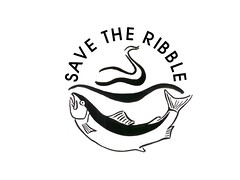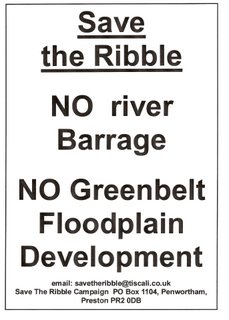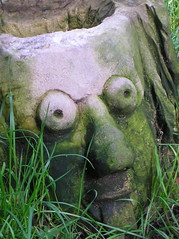Ribble Coast & Wetlands Walking Festival - Ribble Way Walk to Brockholes Wetland
For the opening event in the first ever Ribble Coast & Wetlands Walking Festival, Save the Ribblers organised a Ribble Way Walk along the river banks from the Old Tram Bridge connecting the Penwortham Green Belt to Avenham & Miller Parks to Brockholes Wetland.
The route for this walk was chosen as an ideal opportunity to celebrate the designation of the Ribble as a Regional Park and Brockholes Wetland as the latest - and biggest - Wildlife Trust Nature Reserve in Britain, and the latest addition to the Ribble's Wetlands.

Brockholes Wetland Nature Reserve.

The River Ribble at Brockholes.
A keen band of Ribblesiders from South Ribble and Preston had a very enjoyable day - despite the occasional drizzle - spotting a huge number of bird, plant, and insect life along the Ribble's banks...


It was low tide when we left the Tram Bridge, a great time to spot the numerous bird species feeding in the exposed riverbed - or interrupting their breakfast to watch us as we watch them!

As we moved further upriver, the low waters rushed over the riverbed and a large family of Goosander were enjoying the ride...

Riverbank plants are hugely diverse - particularly in the spots where Himalayan Balsam has either been cleared or hasn't yet taken a hold, this Burdock provided a great deal of enjoyment to the younger members of the group who spent a portion of the walk throwing the burred buds onto one another...

We decided to walk along the Ribble Way Cycle path from the Shawes Arms to Mete House as the riverbank fields here have cattle and we decided that this was best avoided with the recent Foot & Mouth outbreak as it's best to be cautious in these early days...
This was no hardship however as the views are spectacular...


The Ribble from the edge of Mellings Wood...
The walk took us through Mellings Wood...

...and past the Ribble at Cuerdale Hall, site of the famous treasure find, the Cuerdale Hoard...

...although other great treasures are to be found on the riverbanbks along the Ribble here, including Kingfishers and Sand Martin colonies...

...before we arrive at the beautiful vista of the River Ribble at the Tickled Trout...

Lower Brockholes Farm runs down to the river here, on the Preston bank...

...although this farm will soon change forever once the aggregate quarrying begins here too.
At Brockholes Wetland, the Reserve Manager, Sophie Leadsom, welcomed us to the Reserve, and very kindly gave us our own personal guided tour of the site, explaining the enormous amount of work she needs to do before the site is opened to the public...

The site can still be accessed by the Ribble Way footpath, which runs right through the centre of the new reserve, plus there is a permissive footpath which follows the loop of the Ribble as it curves around the area. The rest of the site will not be open to the public at least until safety work is completed - this was until recently a working quarry and some areas of the site are very dangerous - and some basic works have been undertaken.
Even though much of the site is beautiful and green, Sophie explained that a great deal of work has to be done even here as Willow has self-seeded on the shores and islands which - until this summer - were home to the largest colony of Whimbrel in the country. This year the Whimbrel have not nested on the islands at Brockholes as they prefer much less cover which can hide their predators.

Nonetheless, the wildife which is already supported here at Brockholes is staggering - and with the improvements Sophie has in mind, this Reserve will be one of the most important wildlife sites in Lancashire, providing sections of all kinds of traditional Lancashire habitat along with the lakes themselves...

Including woodlands and both wet meadows and dry...


...which will mean even more wildflowers and grasses and other plant species will cover the area...

...including such species as Tufted Vetch and Birds Foot Trefoil...

...Mallow...

... and Meadow Cranesbill...
But, beautiful though they are, the plants aren't the most important species in the foodchain, it's the insects which are attracted to the plants which are the most important of all, providing essential energy to the numerous bird species which now populate this Wetland...

Cinnabar Moth Caterpillars on Ragwort

Probably Peacock Butterfly caterpillars...

Demoiselle Dragonflies have joined the huge numbers of Common Blue and other Damselflies and Dragonflies which are abundant at Brockholes.
On the site of the most recent quarry excavations, Sophie explains how this barren stony ground will become a lush wetland meadow within 3 years...

...and because it will be properly managed from the very beginning, Sophie will be able to avoid having to do all the extra work on this area that she is having to do on the more mature lakes and meadows. This includes having to reduce the height levels of the islands, extend and grade the slopes into the water to remove the steep drops into the quarry bottom which currently exist (which reduce habitat provision), and remove the invasive plant species which will interfere with these special habitats at Brockholes.

The bird and insect species at Brockholes is already so impressive it allowed the Wildlife Trust to put forward their proposals to protect the site from development - managing to purchase the site at the beginning of the year despite a scarily short deadline with the generous help of local people.

Geese...

and Lapwing were amongst the birds which showed off for us while we were here.

The Ribble as it curves around Brockholes here is extremely beautiful, and as well as Geese and Sand Martins alongside more Damoiselle flies on the banks here, we had the privilege of a close view of a Kingfisher.
We had a picnic lunch and a rest at Brockholes, although one member of the party had an even bigger rest before the walk back...

Our Brockholes tour over, we had the pleasure of the walk home along the Ribble's beautiful banks, back downriver past Cuerdale Hall...

...Mete House, where other Ribblesiders were enjoying the clear and warm afternoon on the riverbanks...

...before reaching the Tram Bridge in time for high tide...

Along with a number of swans, a cormorant was fishing for his supper, and the breeze was rustling through the riverside trees...

...so we spent a good while enjoying more of this summer day messing about on the riverbank...
...and we take in the waving heads of the Barley on our way back downriver to Old Penwortham Bridge...

- although an unexpected and unwelcome disturbance scattered the swans and ducks and cormorants and gulls in all directions, and we all quickly left for home rather than have our Ribbling afternoon spoiled...

There are many more Ribble Coast & Wetlands Walking Festival Events, including a number local to South Ribble and Preston, including Fishwick Bottoms, our local Parks, Longton Brickcroft, amongst many others, as well as further afield at Crossens, Southport, Martin Mere, and Granny's Bay.
For more information, see Ribble Events, or follow the links to the Ribble Coast & Wetlands Walking Festival at Mersey Basin.
savetheribble@tiscali.co.uk
Labels: biodiversity, birdwatching, brockholes, Pictures, ribble, ribble way, walking, wetlands















0 Comments:
Post a Comment
<< Home